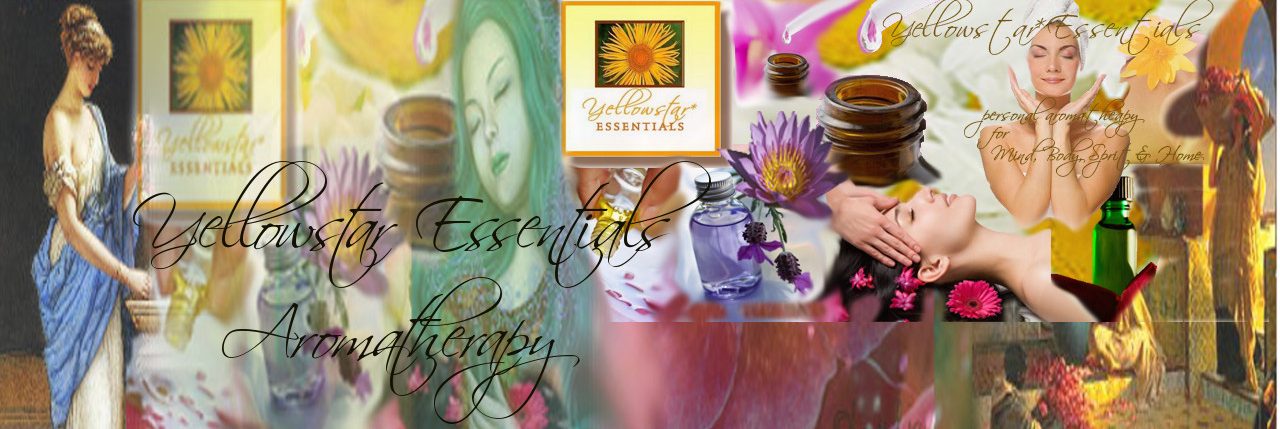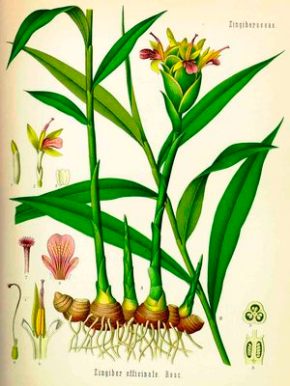I love the spicy, sexy, fresh, and sometimes earthy scent of ginger! It’s perfect for the cold winter months, and is such a lovely warming essential oil, I’m sure you’ll find some wonderful uses for it. Read on for more ideas.
It’s a fabulous essential oil to use in perfumery or aromatherapy for a number of reasons. I found lots of great info….(thank you CaFleureBon! and Divine Caroline!)
Ginger is a spice, biting sometimes, fresh and mild if young and tender, hot and fragrant when mature, and quite potent when old. It may be called gingembre in French, gingifere in Old English, even inji ver (Tamil) or by its scientific name Zingiber officinale. Other members of this fragrant family include ginger lily, galangal (Thai ginger), turmeric, and cardamom. Ginger lily rhizomes and flowers both produce fragrant products that may be distilled or extracted for perfumery. There are more than 1000 species in the ginger family from Africa, Asia, and the Americas and many of them are fragrant. All have large rhizomes or underground stems that are fleshy and often spicy. Many are used as ornamental plants having unusual flowers and attractive foliage. The flowers and leaves may also be used in food preparation in addition to the rhizome. From this large family with scented leaves, flowers, seeds, and rhizomes we get a wondrous variety of fragrant products but it is ancient and complex ginger that is most familiar and perhaps most widely used.
Ginger can be used in aromatherapy preparations to reduce nausea, inflammation and help circulation. Ginger is also a very strong antiseptic and antibacterial and is widely used in many countries to prevent or heal colds and just to support the immune system.
Ginger essential oil is used in perfumery to add spice and depth to Oriental or spice blends. It’s also valuable for incense or gourmand fragrances and a tiny bit will add interest to florals. When fresh ginger is distilled it keeps a light, lemony and fresh ginger note that is lovely with citruses and tropical florals. Fresh ginger essential oil has a true zingy ginger odor highlighted by a lemony topnote while the other has a deep, spicy, woody scent sometimes accompanied by a hint of earthiness. Fresh ginger essential oil adds an interesting unique vibrancy to oriental perfumes. While it is often compared to black pepper or cinnamon bark, its spice is fresh and uplifting. Fresh ginger is unexpected and original and adds freshness, heat and spice to floral blends. It blends well with amber, bitter orange, petitgrain and pink lotus. It is worth seeking out a truly great fresh ginger as many ginger essential oils on the market can have a “cooked” note and lack the vibrancy that a good quality fresh ginger oil possesses.Two types of essential oil are produced from ginger, one from the dried rhizome and one from the fresh rhizome. There are three main components, zingerone, shogaols,and gingerols that make up about 1 – 3 percent of the weight and give the characteristic odor and flavor.

Ginger can stimulate the circulatory system and warm the body, all influences that may contribute to its effects as an aphrodisiac. It also increases the heart rate and circulation. Perhaps the spicy rich fragrance is also a signal for romance and passion. Avicenna, the ancient Arab physician credited ginger with increasing lustful yearnings and as a cure for impotence. The French Courtesan, Madame du Barry, who was mistress to Louis XV, was said to feed ginger to her lovers to make them completely submissive to her desires. The Kama Sutra mentions it as an enhancement for love making. In Senegal women have worn belts containing ginger roots to enhance their partner’s desire and it has been used in love rituals throughout Asia and the South Pacific. Sometimes known as the plant of burning desire, ginger has spice, it has a sweet richness, it has complexity and a sharp tang. Keep a bit of ginger around as an important ingredient in the formula of love.
See the rest of CaFleureBon’s post here and maybe win some prizes!.
Ginger for Stomach Upsets and Pregnancy Morning Sickness
It is believed that ginger (zingiber officinale) was brought to Europe between the 10th and 15th century to be used as a condiment. It has been used for medicinal purposes since the ancient times and is recorded specifically in both Chinese and Sanskrit writings. It is also mentioned in the classic literature from the Greeks and was used in the sybaritic sanctuaries of the Romans. The essential oil is extracted by steam distillation from the ginger root.
Ginger has been revered for thousands of years as a universal medicine, especially in countries such as China and India. The Spanish introduced ginger to the West Indies in the 16th century, and today it is renowned for its healing properties and recognized as a popular spice. Ginger root is well known as a culinary herb used in Asian cooking, but in aromatherapy, ginger essential oil kicks a punch for many different aliments, especially fast relief for easing an upset stomach.
It may be inhaled from a tissue to alleviate indigestion and morning sickness during pregnancy. Ginger oil is a nice addition to your massage oil or body scrub, as it can ease minor aches and pains. The warming properties of ginger oil makes it a wonderful choice for a soothing yet invigorating bath and will help improve circulation.
For treating bruises and sores on the skin, ginger is one of the best oils and rubbing it on the affected areas should speed the healing process, and ease the pain associated with the injury. In steam inhalations, it is helpful for colds and flu, and its germicidal properties make it an excellent choice to combat infections. As one of the more odoriferous oils, ginger should be used in moderation, but as you can see, the affinity with orange is unmistakable.
The emphasis when blending essential oils is on the final aroma, not its therapeutic properties. Orange and ginger together create a beautiful fragrant bouquet, with the added bonus being that they also work really well therapeutically.
Add three drops of orange and two drops ginger to your favorite carrier oil. The best carrier oils to use when making a massage blend are jojoba oil and sesame seed oil. Jojoba oil has a very similar chemical makeup to our own skin’s composition, plus during massage, it keeps the skin lubricated to prevent damage. Sesame seed oil plays a vital role because it penetrates into the skin readily and helps remove toxins. A basic massage blends consist of four to five drops of essential oils and one cup of carrier oil. Shake to mix well. Read the rest of divine carolines’s article here.
1. Midnight Poison by Dior
2. Elle by Yves St Laurent
3. DKNY Delicious Night by Donna Karan
Also; ginger is lovely with any citrus and floral essential oils such as jasmine, neroli, pink lotus, and lots of others. Have fun with it!




Ginger has always been one of my favorites! Thanks for the fun info!
Awesome post
Thanks for sharing this